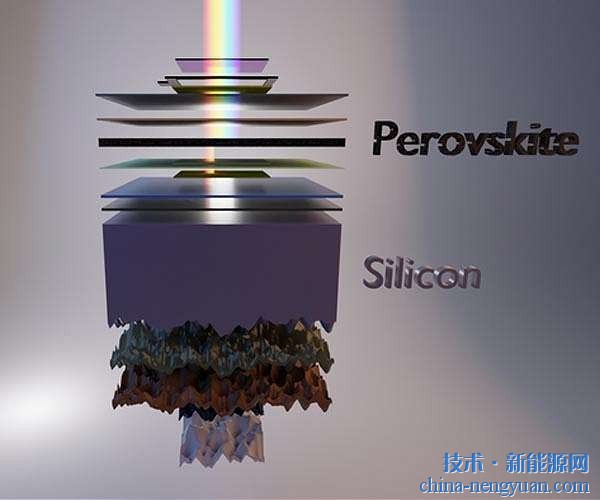 |
Editor's note: In fact, we live in a world that is "lazy" and "does not love clean."
According to the basic law of thermodynamics, without external intervention, she always goes toward energy (it only costs money, never makes money), and has a higher degree of confusion (things can only be thrown away and never cleaned).
As the most wise species on earth, humans, in addition to being happy to change the "pure" into a "mixed" evil taste, can actually rely on some whimsy to use nature's "do not love clean" principle and thus rely on a layer of magical The film turns this evil taste into real electric energy, and the efficiency is still very considerable.
In simple terms, it is often the case that pure water and salt water are put together and only light salt water is always obtained. This is a basic common sense, but nowadays human beings are playing “magic†and can also obtain electrical energy and can be used for large-scale power supply.
The clean energy family consisting of solar energy, wind energy and hydropower has added a new member: permeation energy. More precisely, fresh water and seawater interact through a semi-permeable membrane to generate energy, which humans can now use to generate electricity.
Scientists at the École polytechnique fédérale de Lausanne Nanobiology Laboratory in Lausanne, Switzerland, have recently developed a new type of penetrating power generation system that generates more electricity than previously thought. The core technology of this invention is a three-atom-thick film that separates two liquids.
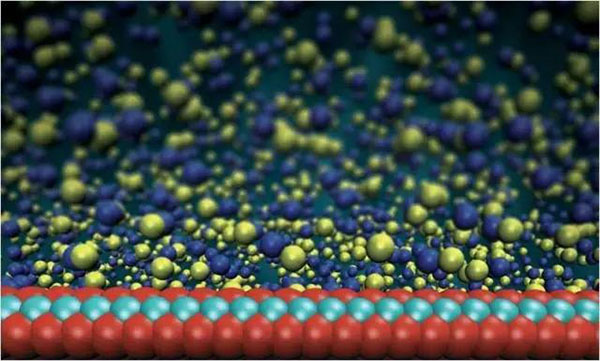
3 atom thick semipermeable membrane. Steven Duensing, National Center for Supercomputing Applications, University of Illinois at Urbana-Champaign.
The results of this study were published in the journal Nature on July 13th.
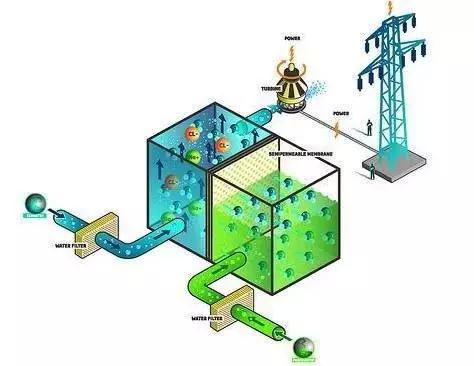
The basic principle of osmotic power generation is simple. A semi-permeable membrane separates the water with different salt content. The water molecules cannot pass through the membrane, but the salt ions can.
In this way, salt ions will continue to run from salt-concentrated water to low-salt water until the salt concentrations of fresh water and salt water are the same. Since the salt ions are charged, the movement of the salt ions creates a current.
3 atoms thick film to do everything
The experimental system at the Federal Institute of Technology in Lausanne, Switzerland consists of a container divided into two parts. Each part is filled with different concentrations of salt water. Between these two types of salt water is a semi-permeable membrane with a thickness of 0.65 nm. (See below).
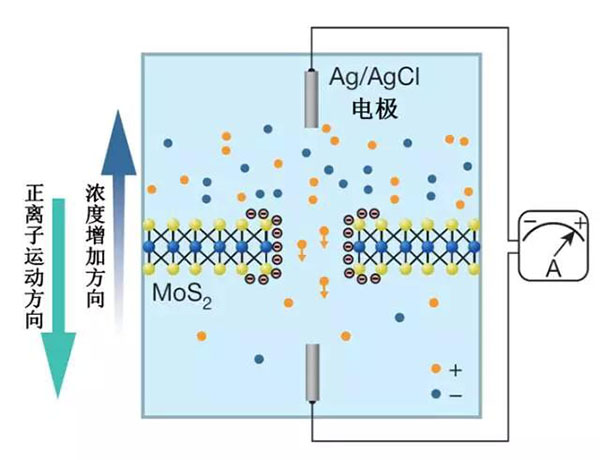
Permeation energy works: The MoS2 membrane with nanopores separates the two waters with different salt content, and the salt concentration is higher at the top of the picture. The difference in concentration causes a difference in chemical potentials on both sides, so ions in the brine will diffuse toward low concentrations. Since the nanopore is negatively charged, only positive ions can pass through the nanopore, so eventually a potential difference is generated and electricity can be supplied outward. Photo credit: JiandongFeng et al,, Nature 2016
The material that constitutes the semipermeable membrane is molybdenum disulfide (MoS2) with nanometer-sized pores (ranging from 2-25 nanometers in diameter) on the membrane. Salt ions can pass through the pores to the other side until the salinity of the two parts. Consistent.
As the salt ions pass through the pores, the electrodes receive the charge carried by the ions and form an electrical current.
As a semipermeable membrane that is the core component of osmotic power generation, its greatest feature is that all nanopores are negatively charged, so only positive ions are allowed to pass, and negative ions are blocked in situ.
In this way, the positive ions in the brine continuously enter the dilute brine due to the concentration difference, but the negative ions remain in the brine.
Eventually, voltages are formed across the semipermeable membrane so that electricity can be generated.

The nanopores on the semipermeable membrane were "drilled" with a transmission electron microscope (TEM) electron beam, and the aperture on the graph was approximately 5 nanometers. Photo credit: Jiandong Feng etal, Nature 2016
According to Jiandong Feng, chief scientist, the team identified for the first time the optimal size range of nanopores.
He said that if the nanopore is too large, the negative ions will pass through with the positive ions, which will reduce the voltage; if the nanopore is too small, there will be too few positive ions and the current will be too weak.
In addition, according to the experimental results, the thinner the semi-permeable membrane, the greater the current, and the thin film developed by the Federal Institute of Technology is only 3 atoms thick, so the power generation capability is very strong.
The potential of this semipermeable membrane is very great. According to the research team's calculations, 1 square meter of semi-permeable membrane, 30% of its surface area covered by nano-holes, can generate 1 MW - enough to light up 50,000 standard energy-saving light bulbs.
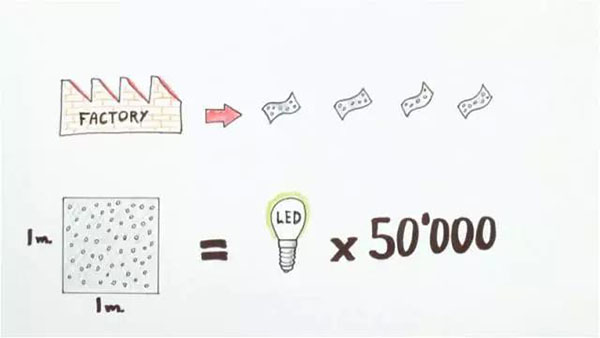
Even better, the raw material for the molybdenum disulfide film material is abundant in nature and it is not difficult to manufacture it at the same time. Therefore, the film has the potential for large-scale promotion.
Of course, the current technical problem is how to ensure that the nanoholes are evenly distributed on the film while expanding the area of ​​the film. Feng Jiandong said that the current research work focuses on thin films with only one nanopore, in order to thoroughly study the mechanism of power generation. Mechanism research can provide a reliable basis for future industrial manufacturing.
Rivers and seas can become huge power stations
For decades, Norway, the Netherlands, Japan, and the United States have all tried to use the rivers to produce electricity. Some systems directly use water to power generators without using thin films, which is virtually identical to traditional dams. There are also systems that make use of the difference in salinity of the estuaries to generate electricity from thin films, but the films are not only too fragile, but also have too low a generating capacity.
The newly invented nanopore film brings ultra-high power generation efficiency due to its extremely thin thickness (see the table below). The energy density of permeation using perforated nanomembrane can be as high as 1 MW/m2, and the theoretical maximum value of solar energy is only 500 watt/m2. Therefore, percolation energy has an overwhelming advantage only from the viewpoint of power generation efficiency. .
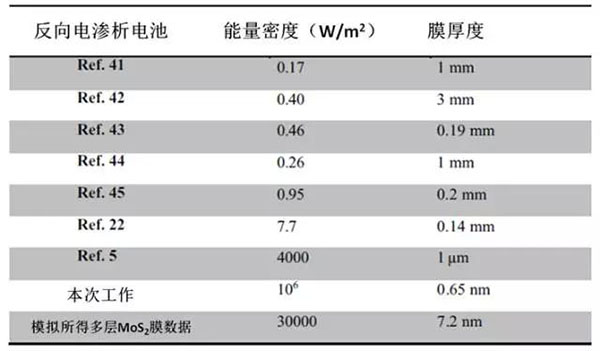
A comparison of the permeation energy generation efficiency of different membranes (Ref. represents various existing power generation membranes) shows that the thinner the membrane, the higher the energy density of the electricity generation, ie, the higher generation efficiency. Source: Jiandong Feng et al, Nature 2016
When the membrane system is improved enough to be put into engineering applications, semi-permeable membrane power generation will become a new force for renewable energy.
In contrast, the energy sources for solar power generation and wind power generation are not sufficiently stable, and the semi-permeable membrane can generate electricity in a stable manner all-weather when there are poor salinity estuaries throughout the day.
FUEL CELL
The GAS-165 fuel cell is designed to operate with the NANSHAN Gas Actuated Tools,and with many major-brand gas-actuated concrete-nailer tools.
The fuel cell provides 1,000 shots and can operate at temperatures between 20° and 120°F (–6°–49°C).
GENERAL
All fuel cells replace conventional Powder Loads and drive more than 1000 shots.
All fuel cells have an expiration date located on the bottom of the can.
DisposalThe fuel cell is basically an aerosol can, check with your local regulations for disposal.
Fuel Safety Instructions
Always store fuel cells where they will not be exposed to an open flame,
sparks or temperatures above 120 degrees F (48 degrees C).
Fuel cells are good for 12 months. Check expiration date on bottom of can.
Fuel Cells For Gas Tool,Nail Gun Gas Fuel Cell,Fuel Cell For Gas Nailer,Gas Nailer Fuel Cell
Sichuan Nanshan Powder Actuated Fastening System Co., Ltd. , https://www.nanshanpat.com